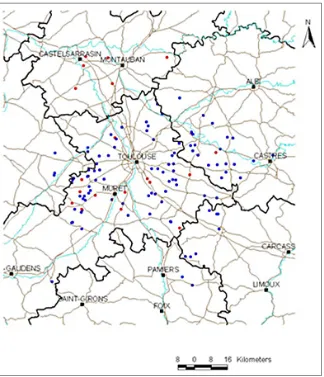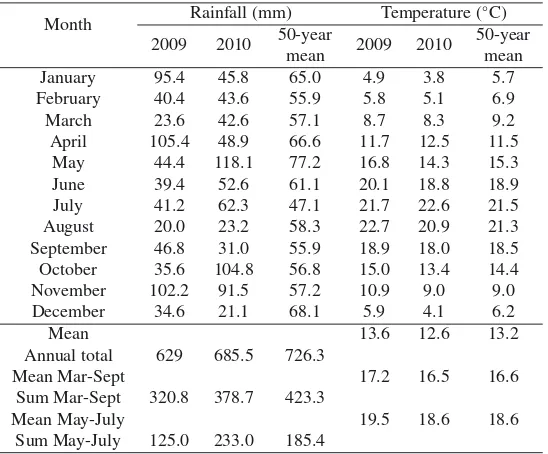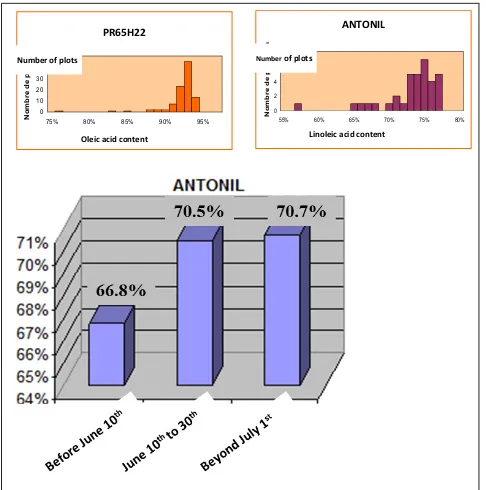DOI:10.1051/ocl/2016039
Available online at: www.ocl-journal.org
Oilseeds & fats Crops and Lipids
OCL
R
esearch
A
rticle
– D
ossier
O
pen
A
ccess
N
EW PERSPECTIVES OF EUROPEAN OLEOCHEMISTRY
L
es nouvelles perspectives de l
’
ol
eochimie europ
´
eenne
´
Effects of technical management on the fatty-acid composition
of high-oleic and high-linoleic sunflower cultivars
Adeline Gouzy
1, Anne Paulhe-Massol
1, Zéphirin Mouloungui
2,and Othmane Merah
21 Arterris Innovation, 24 avenue Marcel Dassault, BP 25802, 31505 Toulouse Cedex 05, France
2 Laboratoire de Chimie Agro-industrielle (LCA), Université de Toulouse, INRA, INPT, 31030 Toulouse, France
Received 21 June 2016 – Accepted 31 August 2016
Abstract – We investigated the effects of several crop management parameters on the fatty-acid composition of very high-oleic (VHO) and a very high-linoleic (VHL) sunflower cultivar. Experiments were performed on these varieties grown on field plots in 2009 and 2010. Yield and fatty-acid composition were determined and the effect of irrigation was investigated at the flowering stage in VHL cultivars. We also evaluated the effects of three sowing dates studied on Antonil, a VHL cultivar. Yield and fatty-acid content were similar in 2009 and 2010. The best results were obtained for PR65H22 (a hybrid cultivar), for which a mean oleic acid content of 93% was obtained in 2009. For the VHL variety, yields were higher for plots irrigated at flowering. Late sowing was associated with higher linoleic acid content, and irrigation at flowering resulted in higher yields and linoleic contents. These results highlight the effects of different types of technical management on the yield and quality of this crop.
Keywords: Crop management/fatty-acid composition/sowing date/sunflower/irrigation
Résumé – Effets de la conduite culturale sur la composition en acides gras des variétés de tournesol à haute teneur en acide oléique et à haute teneur en acide linoléique. Nous avons étudié les effets de plusieurs paramètres de conduites culturales de tournesol sur la composition en acides gras de variétés de tournesol de très haute teneur en acide oléique (THO) et de très haute teneur en acide linoléique (THL). Des expériences ont été effectuées sur ces variétés cultivées sur 96 parcelles en 2009 et 56 parcelles en 2010. Le rendement et la composition en acides gras ont été déterminés et l’effet de l’irrigation a été étudié au stade de la floraison chez les variétés de tournesol THL. Nous avons également évalué les effets de trois dates de semis étudiés sur Antonil, une variété de tournesol THL. Le rendement et la teneur en acides gras ont été plus élevés en 2010 qu’en 2009 pour toutes les variétés. Les meilleurs résultats ont été obtenus pour PR65H22 (une variété hybride), pour laquelle une teneur moyenne en acide oléique de 93 % a été obtenue en 2009. Pour les variétés de tournesol THL, les rendements étaient plus élevés pour les parcelles irriguées à la floraison. Le semis tardif a été associé à la plus forte teneur en acide linoléique, ainsi que l’irrigation à la floraison a donné des rendements et teneurs plus élevés en acide linoléique. Ces résultats mettent en évidence les effets des différents types de conduite culturale sur le rendement et la qualité de cette culture.
Mots clés : Conduite culturale/composition en acides gras/date de semis/tournesol très haut oléique et très haut linoléique/irrigation
1 Introduction
Sunflower is the fourth most important oilseed species worldwide (Oil World, 2012). It is grown mostly for its oil, but a small proportion of the seeds harvested is destined for di-rect consumption in food or feed. Sunflower seeds are achenes. They contain about 45% oil, which is harvested mostly for hu-man consumption, but also for use in industry, particularly in
Correspondence:zephirin.mouloungui@ensiacet.fr
the production of biofuels and biolubricants (Ballerini, 2006;
Rocheet al.,2010). France is the main consumer and producer
of sunflower in the European Union. Oil demand and diversi-fication have increased considerably over the last decade and these trends have promoted breeding for the development of
cultivars with different fatty-acid profiles to meet the demands
of industry.
The desaturase of sunflower, FAD2, naturally transforms its oleic acid into linoleic acid. The dominant high-oleic mu-tation underlying the Pervenets population suppresses FAD2
D
Fig. 1.Map locating the plots used in 2009. All the plots were located around Toulouse (South West France). Red points: VHL sunflower. Blue points VHO sunflower (online version in color).
activity through a gene duplication event leading to silencing
of the FAD2 gene (Lacombe et al., 2009). This silencing
phenomenon is not complete, so even high-oleic sunflower (HO) varieties produce seeds containing at least 5% linoleic
acid (Lagravere et al., 2004). FAD2 is encoded by a
fam-ily of three genes in sunflower. However, the expression of only one of these genes is blocked by the Pervenets muta-tion. This dominant mutation is expressed exclusively in the seed and is strongly influenced by genetic background. Other fatty-acid profiles exist in sunflower and have been developed for specific industrial needs. Cultivars with “high" stearic or palmitic acid levels have been produced, for example
(Perez-Vichet al.,2002; Fernandez-Moyaet al.,2002; Salaset al.,
2007; Serrano-Vegaet al.,2005). Ongoing plant breeding
ef-forts are continuing to generate sunflower varieties with very high linoleic acid or very high oleic acid contents.
FAD2 activity is limited by temperature. Indeed, the fluid-ity of the fatty acids in cell membranes depends on the rate of lipid desaturation: the maintenance of correct fluidity requires lower rates of desaturation at higher temperatures than at lower temperatures. Several studies have shown that oleic acid con-tent increases with cumulative temperature during peak
lipo-genesis activity (Rocheet al.,2006,2010; Baud and Lepiniec,
2010; Merahet al.,2012). It may, therefore, be necessary to
modify cropping practices when growing “technical" varieties. Many studies have highlighted the impact of high
tempera-tures on stearic and oleic acid contents (Fernandez-Moyaet al.,
2002, Perez-Vichet al.,2002; Rocheet al.,2006; Merahet al.,
2012). Few studies have investigated the effect of crop
man-agement on yields and fatty acid contents in VHO or VHL cultivars.
The objective of this study was to investigate the impact of agro-environmental factors on VHO and VHL varieties of sunflower, to determine the most appropriate technical man-agement practices (sowing time, irrigation, etc.) for the vari-eties tested.
2 Materials and methods
The experiments were performed in the Toulouse region in 2009 and 2010, with field plots ofe very high-oleic acid content (VHO) cultivars and one very high-linoleic acid
Table 1.The prevailing weather conditions during the plant growth cycle in 2009 and 2010, and the mean values for the last 50 years.
Month Rainfall (mm) Temperature (
◦C)
2009 2010 50-year 2009 2010 50-year
mean mean
January 95.4 45.8 65.0 4.9 3.8 5.7
February 40.4 43.6 55.9 5.8 5.1 6.9
March 23.6 42.6 57.1 8.7 8.3 9.2
April 105.4 48.9 66.6 11.7 12.5 11.5
May 44.4 118.1 77.2 16.8 14.3 15.3
June 39.4 52.6 61.1 20.1 18.8 18.9
July 41.2 62.3 47.1 21.7 22.6 21.5
August 20.0 23.2 58.3 22.7 20.9 21.3
September 46.8 31.0 55.9 18.9 18.0 18.5 October 35.6 104.8 56.8 15.0 13.4 14.4
November 102.2 91.5 57.2 10.9 9.0 9.0
December 34.6 21.1 68.1 5.9 4.1 6.2
Mean 13.6 12.6 13.2
Annual total 629 685.5 726.3
Mean Mar-Sept 17.2 16.5 16.6
Sum Mar-Sept 320.8 378.7 423.3
Mean May-July 19.5 18.6 18.6
Sum May-July 125.0 233.0 185.4
The cultivars were provided by Pioneer Cie. PR65H22, PR64H41 and PR64H32 are hybrids with high yields and oleic acid contents. Antonil (developed by Pioneer) has very high linoleic acid content. This cultivar flowers very early and was developed for use as a cover crop.). In 2009, all three VHO varieties were sown (over 98 plots), whereas, in 2010, only PR65H22 was sown, on 96 plots. Antonil (VHL) was sown in 2009 (21 plots) and 2010 (35 plots). We also tested three sow-ing dates for this variety: before June 1st, between June 10th and June 30th and after July 1st, in 2010 only.
Temperatures and rainfall were recorded during the two
crop cycles (Tab.1). For the period of the year
correspond-ing to the croppcorrespond-ing cycle, 2009 was the hottest and driest year, and there was more rainfall in 2010. During the grain-filling period, 2009 was less rainy and hotter than 2010.
Flowering began between the end of June and the middle of July, depending on the year. Seed maturity was achieved at the end of July or the start of August.
Grain yield and oleic and linoleic acid contents were de-termined. The fatty acid profile of the seeds was determined by gas chromatography (GC) analysis of the methyl esters of fatty acids. This procedure includes two preliminary steps: the extraction and esterification of fatty acids. The results for each fatty acid are expressed as a percentage of total fatty-acid com-position. The four major fatty acids – oleic, linoleic, stearic and palmitic acid – were determined.
Fatty acids were determined by a method based the solubil-ity of oils in terbutylmethyl ether (TBME; ME0552, Scharlau) and the transformation of fatty acids into their methyl esters (ISO 5509 standard: 1990). Seeds were ground in 5 ml TBME.
A 2 ml was then passed through a GHP filter with 0.45µm
pores. We then mixed 50µl of 0.2 M trimethylsulfonium
hy-droxide in methanol (Macherey-Nagel) with 100µl of the
fil-trate according to theNF EN ISO 12966-3 standard. The
re-sulting mixture (1µl) was injected, via an automatic sampler,
into a GC-3800 chromatograph (Varian) equipped with a FID
Table 2.Yield and fatty-acid contents of sunflower seeds during the two years of experiments in the Toulouse region.
Type Trait Water condition 2009 2010
VHO Yield (t/ha) Rain-fed 2.1 2.3
Oleate content (%) Rain-fed 90.9 91.5 VHL Yield (t/ha) Irrigation (flowering) 1.9 –
Yield (t/ha) Rain-fed 1.4 1.2 Linoleate (%) Rain-fed 69.1 73.2
Table 3.Fatty-acid contents for the cultivars studied during two years of experiments in the Toulouse region.
Year Type Cultivar Fatty acid content (%)
2009 VHO PR64H32 90.2
2009 VHO PR64H41 89.5
2009 VHO PR65H22 93.0
2010 VHO PR65H22 91.5
2009 VHL Antonil 69.1
2010 VHL Antonil 73.0
detector. The GC was also equipped with a CP Select CB 50 m capillary column (D: 0.25 mm). The initial oven
tem-perature was maintained at 185◦C for 40 min, then increased
at a rate of 15◦C/min to 250◦C, this temperature then being
maintained for 10 min. The injector and detector temperatures
were 250◦C. The fatty acid methyl ester (FAME) proportions
were determined by comparison with the retention times of a known standard mixture of FAMEs (a fatty acid methyl ester mixture from oilseed rape, Supelco, USA), used as an external standard.
3 Results and discussion
Tables2and3present seed yields and oleic acid contents
for the three VHO varieties in 2009 and PR65H22 in 2010.
D
PR65H22 0 10 20 30 40 50
84% 89% 94%
Teneur en acide oléique
No m b re d e p a rc elles
Oleic acid content
Number of plots
Number of plots
Oleic acid content
Number of plots
Oleic acid content
Fig. 2.Distribution of oleic acid content for VHO sunflower harvested in 2009.
RESULTATS ANTONIL 0 2 4 6 8
55% 60% 65% 70% 75% 80% Teneur en acide linoléique
N o m b re d e p a rc e lle s RESULTATS PR65H22 0 10 20 30 40 50
75% 80% 85% 90% 95%
Teneur en acide oléique
N o m b re d e p a rc e lle s
Number of plots
Oleic acid content Number of plots
Linoleic acid content
PR65H22 ANTONIL
Fig. 3.Impact of sowing date on linoleic acid content in Antonil (VHL sunflower cultivar) in 2010.
Seed yields were similar the two years and in the normal range for non-irrigated crops in south west France.
In 2009, the oleic acid content of PR65H22 was slightly higher than those of the other two VHO varieties, and showed
the least variation between fields (Fig.2). In 2010, results were
very similar, the slightly lower mean for this variety probably
being due to a few plots with lower oleic acid contents (Fig.3),
which could result from some pollination by other sunflower varieties.
For Antonil (VHL sunflower), linoleic acid content was higher in 2010 than in 2009, but yield was slightly higher in
2009 than in 2010. These findings may reflect the differences
in climatic conditions between 2009 and 2010 (Tab.2). Crop
management practices were also more appropriate in 2010 than in 2009.
In 2009, we compared rain-fed and irrigated conditions (at sowing and flowering) for the VHL cultivar. Higher yields were obtained for this cultivar if the plots were irrigated at
flowering (1.9 t/ha), the mean yield obtained for the rain-fed
crop being only 1.4 t/ha.
Sowing date affected linoleic acid content, which was
higher if the seeds were sown after June 10th (Fig. 3).
Linolenic acid content seemed to be increased by lower tem-peratures at flowering or perhaps by a short photoperiod. It was increased by irrigation at flowering. Our results highlight the importance of careful technical management to get the most out of these crops.
4 Conclusion
Our results show that yield and oleic acid content depend on the cultivar used and on crop management practices. Oleic acid levels are stable over a large number of plots and 2 years
with a slightly different weather conditions for VHO varieties.
practices for manipulating yield and oleic or linoleic acid con-tent. Further studies are required to confirm these results and to optimize seed production and the levels of specific fatty acids in in sunflower seeds.
Acknowledgements. Funds for this study were provided by the FUI OLEOVISION program (FUI-AAP7-OLEOVISION 36520), and the Midi-Pyrenées regional authority. This work was also supported by the EFDR and the French Ministry of Industry (DGSI). We thank the Arterris team and farmers, the Pioneer Company and researchers from theEcole d’Ingénieurs de Purpanat Toulouse for their practical input. The authors would like to thank Félicity VEAR for the revision of the manuscript.
References
Baud S, Lepiniec L. 2010. Physiological and developmental regula-tion of seed oil producregula-tion.Lipid Res.49: 235–249.
Fernandez-Moya V, Martinez-Force E, Garces R. 2002. Temperature effect on a high stearic acid sunflower mutant.Phytochemistry59: 33–37.
Lacombe S, Souyris I, Berville AJ. 2009. An insertion of oleate de-saturase homologous sequence silences via siRNA the functional gene leading to high oleic acid content in sunflower seed oil.Mol. Genet. Genom.281: 43–54.
Lagravere T, Kleiber D, Surel O, Calmon A, Bervill A, Dayd J. 2004. Comparison of fatty acid metabolism of two oleic and one con-ventional sunflower hybrids: a new hypothesis.J. Agron. Crop Sci.190: 223–229.
Merah O, Langlade N, Alignan M, et al.2012. Genetic control of phytosterol content in sunflower seeds.Theor. Appl. Genet.125: 1589–1601.
Perez-Vich B, Garces R, Fernandez-Martinez JM. 2002. Inheritance of high palmitic acid content in the sunflower mutant CAS-12 and its relationship with high oleic content.Plant Breeding121: 49–56.
Roche J, Bouniols A, Mouloungui Z, Barranco T, Cerny M. 2006. Management of environmental crop conditions to produce useful sunflower oil components.Eur. J. Lipid Sci. Technol.108: 287– 297.
Roche J, Alignan M, Bouniols A, Cerny M, Vear F, Mouloungui Z, Merah O. 2010. Sterol content in sunflower seeds (L.) as affected by genotypes and environmental conditions.Food Chem. 121: 990–995.
Salas JJ, Moreno-Perez AJ, Martinez-Force E, Garces R. 2007. Characterization of the glycerolipid composition of a high-palmitoleic acid sunflower mutant.Eur. J. Lipid Sci. Technol.109: 591–599.
Serrano-Vega MJ, Martinez-Force E, Garces R. 2005. Lipid charac-terization of seed oils from high-palmitic, low-palmitoleic, and very high-stearic acid sunflower lines.Lipids40: 369–374.
Cite this article as:Adeline Gouzy, Anne Paulhe-Massol, Zéphirin Mouloungui, Othmane Merah. Effects of technical management on the
fatty-acid composition of high-oleic and high-linoleic sunflower cultivars. OCL 2016, 23(5) D502.


